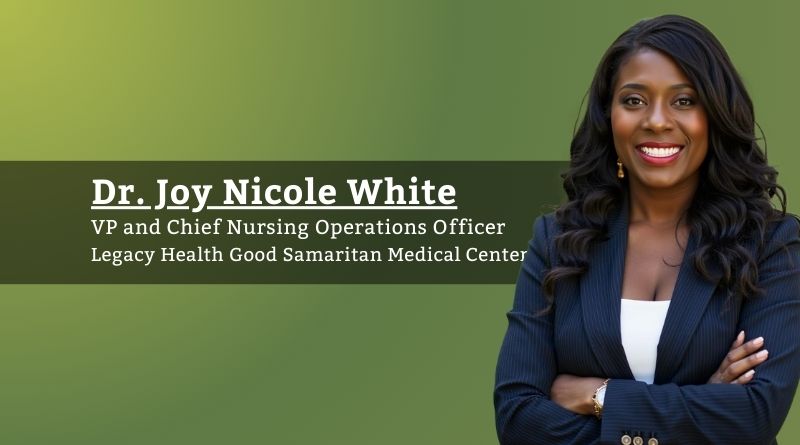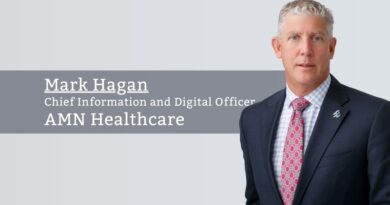More Than a Workforce: Redefining Nurse Retention Through Culture, Belonging, and Leadership
By Dr. Joy Nicole White, VP and Chief Nursing Operations Officer, Legacy Health Good Samaritan Medical Center
In the wake of a global pandemic and during one of the most complex seasons in healthcare history, Legacy Good Samaritan Medical Center is not just managing workforce shortages but also rebuilding the heart of our profession. Our approach to recruitment and retention is not rooted in quick fixes or one-time incentives. It is anchored in something more enduring: human connection, trust, and purpose.
We are no longer just asking, “How do we hire and keep nurses?” We are asking, “How do we build the kind of environment where nurses feel safe, seen, supported—and inspired to stay?”
The Challenge: Compounding Complexity
Our greatest challenge is navigating nursing shortages amid rising patient acuity, financial constraints, and burnout that has outlasted the pandemic. We are also competing with flexible, remote, and gig-style nursing roles that are reshaping the labor market. To meet these challenges, we are reframing staffing not as a numbers game but as a relationship strategy.
We’re not solving a staffing crisis—we’re rebuilding the profession from the inside out. When nurses are seen, supported, and inspired, they don’t just stay—they lead.
Listening Boldly, Leading with Insight
Every meaningful solution begins with listening. We’ve institutionalized this through Checkpoint Chats—intentional, structured dialogues between leaders and staff to uncover needs, resolve issues early, and build relational trust.
In these moments, we’ve discovered what truly matters: nurses want to belong. They want to grow and work in an environment where psychological, physical, and professional safety are not aspirational; they are non-negotiables.
Belonging in Action
Belonging is more than a value; it’s a lived experience. Through our “We Are Good Sam” campaign, we spotlight our diverse team and elevate stories that reflect the lived experiences of our nurses. From day one, nurses experience a soft landing—supportive onboarding, exposure to employee resource groups, and intentional connections with peers and leaders.
We’re also committed to year-round recognition that reflects our values. We celebrate with Daisy Awards, Chat and Chow with the CNO, birthday gatherings, quarterly “Just Us Nurses” town halls, award ceremonies, and more—creating moments that matter.
Pathways with Purpose
We’re not just filling roles—we’re building futures. Our purposeful pathway model supports nurses at every stage. Currently, we’re piloting transitional roles that allow nurses to grow into specialty areas like our Family Birth Center, with structured mentorship and skills development.
We partner with local schools to build a diverse talent pipeline and ensure that new graduates don’t just land—they thrive.
We are also becoming more intentional about developing opportunities for career growth—engaging team members in the design process so that pathways are meaningful, inclusive, and aligned with the real aspirations of our nurses.
We don’t just prepare nurses to do the job—we empower them to imagine what’s possible next. Whether through mentorship, specialty transitions, or co-designed leadership opportunities, we send a clear message from day one:It’s safe to grow here.
This isn’t just about retention; it’s about restoration. We’re rebuilding confidence in the profession, one opportunity, one relationship, and one courageous career step at a time.
Flexibility as a Standard, Not an Exception
To address fluctuations in patient demand, we’re shifting to flexible staffing models that prioritize agility. This includes internal float pools, cross-training for transitional staffing, and real-time communication tools to redeploy resources. These models enhance responsiveness but require investment in coordination, transparency, and trust among teams.
The benefits are clear: more efficient coverage, less burnout, and increased retention of nurses who value balance. The challenge? Ensuring that flexibility doesn’t compromise continuity. We solve this by focusing on team cohesion and consistent leadership presence.
Exploring AI: Co-Creating the Future of Nursing
We are actively exploring, exploiting, and co-creating AI-powered solutions that will enhance—not replace—nursing practice. From automating documentation to improving workload forecasting and clinical prioritization, AI is a powerful ally in streamlining workflows, reducing cognitive load, and ultimately improving patient outcomes.
Rather than relying solely on static dashboards or retrospective analytics, we are moving toward integrated, real-time tools that help leaders and frontline staff make smarter, faster decisions. These technologies will allow us to anticipate staffing needs, optimize team performance, and elevate the nurse’s voice in care planning and decision-making.
Our approach remains clear: AI should enhance efficiency while preserving the human touch. Technology must serve our people—not the other way around.
Preparing for a Virtual and Hybrid Care Reality
We are also exploring the expanding role of virtual care and its intersection with AI to support new models of nursing care. Beyond virtual sitter programs, we are evaluating AI-enabled remote monitoring, virtual nurse consults, and hybrid rounding models that can support both access and quality.
As we envision the future, we understand that virtual care is not just a technological shift; it’s a cultural and clinical transformation. We are preparing our workforce through scenario-based training, leadership development, and future-facing strategy sessions designed to build comfort and competence in these emerging care settings.
By investing now, we are equipping our nurses to confidently lead in environments that blend in-person empathy with virtual precision.
Conclusion: From Strategy to Action
The future of nurse staffing isn’t just about supply and demand—it’s about culture, trust, and human connection.
Here’s a tactical framework any healthcare organization can adopt today:
B.E.A.M. – Build, Engage, Align, Measure
- Build belonging from day one through inclusive, soft landings and authentic onboarding.
- Engage through listening—not just annual surveys but also structured checkpoint conversations with accountability.
- Align talent with purpose by creating career pathways and flexible models supporting life and work.
- Measure what matters—recognition frequency, team trust, psychological safety, and turnover drivers.
We’re not solving staffing with spreadsheets. We’re doing it by caring for people—nurses and patients alike—with bold leadership and a commitment to rebuild the profession from the inside out.

